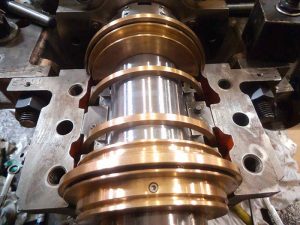Seal upgrade and pump repair in the U.S. midwest boost efficiency and reliability with minimal downtime.
Written by: Ken Babusiak, John Ciffone
Publisher: Pumps & Systems / November 2016
Mechanical seals on pumps in the oil and gas industry often need to be upgraded to meet more stringent standards, such as tighter emissions regulations. More advanced seals also offer companies increased efficiency and reliability.
Older pumps, however, sometimes need to be modified to accommodate these enhancements because the newer parts may not be the same size and shape as the ones they are replacing. In these cases, a parts supplier can partner with an aftermarket engineering firm to come up with a long-term plan for revitalizing older pumps. The refurbished pumps can offer benefits including direct cost savings and a reduction in repair and maintenance.
An Upgrade Plan Emerges
In 2011, a field service engineer was at a pipeline station for service when a technician informed him that the company was considering overhauling all of its pumps as preventive maintenance. The company planned to investigate the possibility of upgrading mechanical seals.
The field service engineer and his team decided to analyze all of the user’s pumping stations from Illinois to Iowa—about 500 miles of pipeline. Every field service engineer who worked on the pipeline met in Cedar Rapids, Iowa, where a regional engineer led a meeting about what would be the best technology solution for this user.
The team decided to replace the existing single mechanical seals with a mechanical seal developed specifically for single-seal installations and designed to attain maximum achievable controllable technology (MACT) compliance in light hydrocarbons and other volatile organic compounds (VOCs).

Image 1. The bottom half of the coupling end bearing housing installed on the pump with the bottom half of the journal bearing, oil rings and seals installed (Images courtesy of Hydro Inc.)
The field service engineers provided information on the pumps in their area, the seal data and the coupling information. All of the pumps would require minor modifications to accommodate these new seals. The team collated information about the pumps and wrote the necessary engineering projects for the preliminary drawings. Once the drawings were approved and finalized, the pumps were sent to a pump repair and service provider to be upgraded to accept the higher-technology seal.
